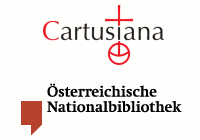Carthusian Libraries and Authors in the Rooklooster RegisterReference marksIn the first half of the first table of reference, the so-called Guelders list, the following charterhouses are mentioned (list Ia):
The hybrid, second half of the first table of reference, has two charterhouses (list Ib):
The second table of reference, the so-called Brabantine list, mentions the following charterhouses (list II):
However, browsing the body of the Rooklooster Register reveals that the reference marks as listed in the tables of reference were not always used consistently throughout the book register. Syllables
Letters
In the section containing the anonymous hagiographic works, the form bruxelle carthusienses was found (fol. 387 r°), referring to the charterhouse of Scheut near Brussels. This reference symbol is not to be found in the tables of reference. The literary legacy of the Carthusian librariesThis survey is restricted to the list of the authors. The number of their works is mentioned between brackets. ANTWERPEN (422 items: 144 authors, 262 lifes of saints, 16 anonymous works)
ROERMOND (168 items: 165 authors, 3 anonymous works)
ZELEM (101 items: 74 authors, 18 lifes of saints, 9 anonymous works)
LIEGE (33 items: 32 authors, 1 anonymous work)
MONNIKHUIZEN (31 items: 29 authors, 1 life of a saint, 1 anonymous work)
GENT (30 items: 27 authors, 2 lifes of saints, 1 anonymous werk)
SINT-MARTENS-LIERDE (5 items: 4 authors, 1 anonymous work)
WESEL (4 authors)
BRUGGE (3 authors)
HERNE (2 items: 1 author, 1 anonymous work)
BRUSSEL (1 life of a saint)
The Carthusian authorsThe number of works is mentioned between brackets.
Some opinionsFrom the above it is clear that the interpretation of letters and syllables is not fixed. As the prologue of the Rooklooster Register says, the sigla in the tables of reference were susceptible to change (Ideo non multum lector confidat litteris et sillabis supranotatis, nam circa illud tempus ubique multa mutata sunt, fol. 1 r°). For this reason it is necessary to study the typology of some characters more in depth, while at the same time researching the provenance of the works. As far as the Carthusian Provincia Teutonica is concerned, it is noteworthy that only one charterhouse of the Northern Netherlands is mentioned, namely the charterhouse of Monnikhuizen near Arnhem (ca. 1335/42). That the houses of Raamsdonk near Geertruidenberg (1336), Noordgouwe near Zierikzee (ca. 1433/34), Vught near Den Bosch (ca. 1465/66), Delft (1470) and IJsselmuiden near Kampen (1485) were left out by the compiler of the Gaesdonck register, might be explained by the fact that they were either completely outside of the geographical sphere of interest or were founded during or after the completion of this catalog (1460/70-1483). It is surprising, however, that the libraries of the older charterhouses near Utrecht (1391) and near Amsterdam (ca. 1392/93) were omitted as well, while the Rooklooster Register did list books from the libraries of the Canons Regular of the Chapter of Windesheim in these cities. Moreover, some charterhouses in the Southern part of the Low Countries are missing from the Brabantine list. Tournai belonged to the French Provincia Picardiae Propinquioris since its foundation (ca. 1376/77) and therefore was not included. The charterhouse of Louvain (1489/91) had not yet been founded at the time of the compilation of the Register of Sint-Maarten (1487/88). It is more difficult to find a reasonable explanation for the absence of the only Carthusian nunnery of the Low Countries, Sint-Anna-ter-Woestijne (1348) in Sint-Andries near Brugge. Were nunneries excluded because of the opinion that their libraries did not contain "intellectual-spiritual" writings, but rather liturgica and works in the vernacular? Yet other evidence shows that the library of the Carthusian nuns owned copies of works by Thomas of Aquino, Jordan of Quedlinburg and Ludolph of Saxony. Nevertheless, the only library of a nunnery mentioned in the Rooklooster Register is that of the augustinian nuns of Gelre, more than likely because of the remarkable reference to the personal library of their confessor. Another striking point is the mismatch between the lists of books mentioned for Carthusian libraries. Judging from the Rooklooster Register, one would tend to believe that one library contained many books, the other little or nothing. However, the Rooklooster Register was in the first place a literature guide and only secondly, as much as possible, a catalog registering the joint possession of monastic libraries. For example, the register only contains three works from the library of the Carthusians of Genadedal near Brugge, all three written by English authors (see above). But research has shown that the Carthusians possessed many more works in the period between 1380 and 1580 (F. Hendrickx, De handschriften van de kartuis Genadendal in Brugge, 1318-1580 , in: Ons geestelijk erf, 47 (1973), 3-63, 241-290, 48 (1974), 143-169). English Carthusians stayed at this charterhouse after the dissolution of the Order in England by Henry VIII in 1538-1539 and after their expulsion from their homeland by Elisabeth I in 1559. It is not inconceivable that at that point in time they brought several works by English authors to Brugge. This fact could possibly point indirectly to the period in which the abbreviation "Gra." was recorded in the book register. Note that these remarks are only intended to highlight the many problems that remain to be examined, case by case, and sometimes in a broader historic context. Only then, the very difficult editorial structure of the Rooklooster Register might possibly be fully fathomed. Frans Hendrickx LiteratureF. Hendrickx, Die Kartäuserautoren und -bibliotheken nach dem Register des Rooklosters bei Brüssel, in: H.J. Roth (ed.), Geschichte und Kultur der Kartäuser. Tagung am 21. und 22. Oktober 1979 in Köln, Bregenz, 1980, 6-10 (= Cistercienser Chronik, 87:1). |
|


